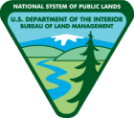This website is the online center for public information for the designated Section 368 Energy Corridors.
The BLM is undertaking a land use planning effort to evaluate modifying (revising, deleting, or adding to) seven designated Section 368 energy corridors (also known as West-wide Energy Corridors). The BLM project website for the Section 368 Energy Corridor Revisions RMPA/EIS can be found on the National NEPA Register.
BLM Publishes Notice of Intent to Amend Resource Management Plans for Section 368 Energy Corridor Revisions and Prepare an Associated Environmental Impact Statement
The U.S. Bureau of Land Management (BLM) published a Notice of Intent in the Federal Register on December 1, 2023, to “Amend Resource Management Plans for Section 368 Energy Corridor Revisions and Prepare an Associated Environmental Impact Statement.” The Notice of Intent announces the beginning of the scoping period to solicit public comments and identify issues. The BLM also published the planning criteria that will guide the planning effort for public review. The BLM requests that the public submit comments concerning the scope of the analysis, potential alternatives, and identification of relevant information by February 2, 2024. Project information, maps, and information on how to submit comments can be found on the National NEPA Register.
The BLM will hold four in-person and two virtual public scoping open houses to learn about the energy corridors and inform the public on how to provide effective comments.
Visit the News and Events page for details, including dates and locations of the open houses.
Section 368 of the Energy Policy Act of 2005 (the Act) directed the Secretaries of Agriculture, Commerce, Defense, Energy, and the Interior to designate under their respective authorities corridors on federal land in 11 Western States for oil, gas, and hydrogen pipelines and electricity transmission and distribution facilities.
Based upon the information and analyses developed in the West-wide Energy Corridor Programmatic Environmental Impact Statement (WWEC PEIS), the Secretaries of the Interior and Agriculture signed Records of Decision (RODs) in 2009. The RODs approving amendments to 92 BLM resource management plans (RMPs) to designate approximately 5,000 miles of Section 368 energy corridors on BLM-administered lands in Arizona, California, Colorado, Idaho, Montana, Nevada, New Mexico, Oregon, Utah, Washington, and Wyoming. For information about the 2009 WWEC PEIS, see the PEIS page.
In July 2009, several organizations filed a complaint against the Agencies challenging the PEIS, DOI and USFS RODs, and associated Section 368 energy corridor designations. In July 2012, the BLM, USFS, Department of Energy (DOE), and the Department of Justice entered into a Settlement Agreement with the Plaintiffs that contains specific actions to resolve the challenges in the Complaint, including conducting reviews of the designated corridors, and identifying recommendations for potential revisions, deletions, and additions to the corridors.
In April 2022, the Agencies issued a final report outlining the recommendations from the regional reviews for potential adjustments to the designated Section 368 energy corridors. The Final Report supported modifications to certain corridors on the basis that: portions of the corridors did not effectively meet demand from new energy sources, including wind and solar; the presence of sensitive resources have inhibited Section 368 energy corridors from being used as intended; and physical pinch points present limitations on potential future development.
For more information about the Settlement Agreement, including timeline, documents, implementation of periodic reviews, agency guidance and training, and the corridor study, see the Settlement Agreement page. For more information about the Regional Reviews, including the Final Report, see the Regional Reviews page.

 Corridor Mapping Tool
Corridor Mapping Tool
